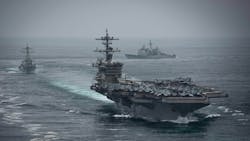Navy picks 13 companies to develop and maintain computer software and hardware for aviation strike planning
PATUXENT RIVER NAS, Md. – U.S. Navy aviation experts are asking 13 companies to share nearly a half-billion dollars to develop and maintain computer software and hardware over the next five years for Navy strike planning.
Officials of the Naval Air Systems Command at Patuxent River Naval Air Station, Md., announced a potential $497.5 million contact to these 13 companies on Thursday for the Strike Planning and Execution Systems hardware and software development and sustainment project.
The 13 companies are:
-- American Electronic Warfare Associates (AMEWAS) in California, Md.;
-- BAE Systems in San Diego;
-- DCS Corp. in Alexandria, Va.;
-- Gnostech LLC in Warminster, Pa.;
-- Long Wave Inc. in Oklahoma City, Okla.;
-- Monterey Technologies Inc. in Park City, Utah;
-- Northrop Grumman Corp. in McLean, Va.;
-- Perspecta Engineering Inc. in Chantilly, Va.;
-- The Raytheon Technologies Corp. Intelligence, Information and Services segment in Dulles, Va.;
-- SOLUTE Inc. in San Diego;
-- Tyonek Engineering and Agile Manufacturing LLC in Warner Robins, Ga.;
-- Young's Engineering Services Inc. in Syracuse, Utah; and
-- KIHOMAC Inc. JV in Layton, Utah.
These companies will develop, integrate, test, evaluate, deploy, deliver, modify, operate, and sustain Navy strike planning hardware and software products supporting domestic and Foreign Military Sales customers, Navy officials say.
BAE Systems, DCS, Raytheon, Perspecta, and Northrop Grumman were part of the original project. Original contractors no longer part of the project are Dynetics Inc. in Huntsville, Ala; Progeny Systems Corp. in Manassas, Va.; Tapestry Solutions Inc. in San Diego; and Lockheed Martin Corp. in Bethesda, Md.
Naval Air Systems Command is awarding the contract on behalf of the Navy Strike Planning and Execution Systems program office (PMA-281). This office develops software and hardware rapidly for three primary product lines: Common Control System (CCS); Naval Mission Planning System (NavMPS); and Theater Mission Planning Center (TMPC).
The CCS provides common control for Navy unmanned systems to add scalable and adaptable warfighting capability; cyber security; eliminate redundant software development; and improve cost control using a modular open services architecture.
The CCS provides unmanned systems vehicle management software; supports vehicle and mission management, as well as mission planning software; and adds common software solutions.
Related: Lockheed Martin to design full-up prototype decision aids to plan complex aerial warfare
NavMPS automates mission planning across 40 types of Navy and Marine Corps aircraft, and supports programs like Joint Mission Planning System-Maritime (JMPS-M); Joint Mission Planning System-Expeditionary (JMPS-E); Electronic Kneeboard (EKB); Common Munitions BIT/Reprogramming Equipment (CMBRE); Weaponeering and Stores Planning (WASP); and Tactical Terrain Visualization System (TTVS).
TMPC helps perform detailed planning and targeting for the Tomahawk cruise missile and provides command and control for the overall Tomahawk weapon system, including flight and route data for navigation from the initial preplanned waypoint to the target.
On this contract, the 13 companies will provide feasibility studies; design and develop hardware and software; deliver and deploy software code; handle engineering change proposals; provide help desk support; and maintain products.
On this contract, the 13 companies will do the work at locations to be determined on individual orders, and should be finished by April 2025. For more information contact Naval Air Systems Command at www.navair.navy.mil, or the Navy Strike Planning and Execution Systems program office at www.navair.navy.mil/organization/PMA-281.

John Keller | Editor-in-Chief
John Keller is the Editor-in-Chief, Military & Aerospace Electronics Magazine--provides extensive coverage and analysis of enabling electronics and optoelectronic technologies in military, space and commercial aviation applications. John has been a member of the Military & Aerospace Electronics staff since 1989 and chief editor since 1995.

